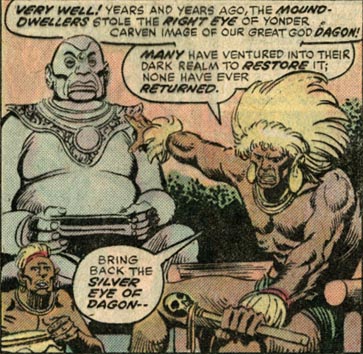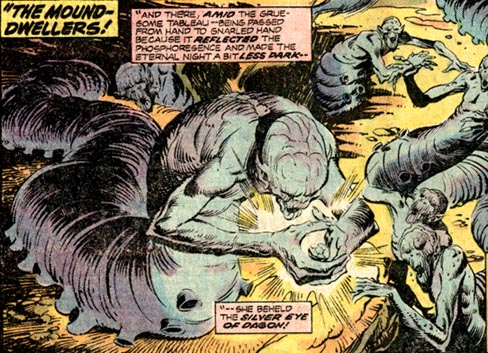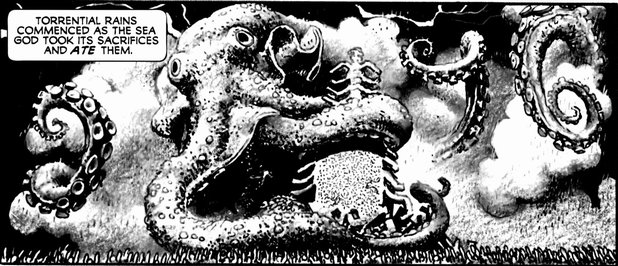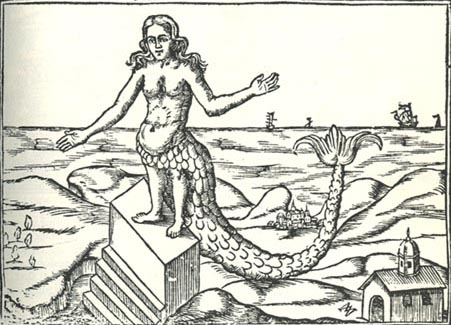 DAGON
DAGON  DAGON
DAGON
Real Name: Dagon
Identity/Class: Hyborian God/Demon; Hyborian Era
Occupation: God of Death; God of Water, and Aquatic Life
Group Membership: Hyborian Gods
Affiliations: Hyborian God worshipped by
the people of Kush and Zembabwei;
undead fish-men sometimes known as the Deep Ones
(servitors),
Khosatral Khel (vassal entity, see comments);
possibly later worshipped by the Philistines and Phonecians;
Enemies: Unidentified
marine scientist, perhaps Derketo, the
Mound-Dwellers;
Bearers of the Elder Sign;
the Hebrew God (Samuel 5:1-7), Enkidu, Gilgamesh,
possibly Pazuzu
Known Relatives: Derketa/Derketo (wife);
Bêlit (step-daughter);
Baal (son
of the Phoenician God Dagon's incarnation as El);
see comments
Aliases: Possibly Enlil, Kumarbi
Base of Operations: Kush c. 16,000 to
5,000 BC (now part of modern-day Sudan),
An unnamed fishing port in the Hyborian era, possibly the
many-columned city of Y'ha-nthlei beneath the Atlantic Ocean
millennia later;
possibly later the Philistine city of Ashdod
much later a small island in the South Pacific
First Appearance:
(historical) the Bible (Judges 16:23),
(print) "Dagon" (November, 1919 The Vagrant);
(Marvel Universe)
Powers: The Hyborian God has superhuman strength (Class 50 possibly), stamina, reflexes and resistance to injury. He has several rather undefined mystical occult powers such as the ability to resurrect the dead as zombies, and to procure the souls of mortals to retrieve back to his realm.
The fish-monster Dagon is an giant amphibious creature composed of tentacles, fins, and fanged mouths connected to an unseen central body. The tentacled form of Dagon likely possesses greater enhanced strength than the humanoid Dagon due to it's larger size and greater leverage, likely somewhere in the 90-100 ton range. It can control the tides and provide bountiful catches for its followers. It is unknown if Dagon in this form can survive indefinitely out of water. In addition, it can transform humans into nigh-immortal ichthyoidal servitors.
History: (Official History of the Conan Universe#1)- Dagon was one of the primeval gods of the Hyborian Age, a section of time that existed between the end of the Stone Age and the before the Bronze Age (between 16,000 and 5,000 BC). Worshipped by ancient Kushite tribes, Dagon was their god of death who took souls back to the underworld as a Hyborian version of the Grim Reaper. He was approached by Derketa, the female form of the god Derketo, who appeared to him as his mate.
(Savage Sword of Conan#132 - BTS) <Pre-Cataclysmic era> - The sorcerer Ohris Dehjmal directed a group of fish-like humanoid followers of Dagon to attack Kull.
(Savage Sword of Conan#186 - BTS) - The Hyborian Era
people, excavating lost ruins, found
evidence of a civilization of the above fish-like humanoid followers of
Dagon.
(Conan the Barbarian I#17) - As their ship sank
and they jumped overboard, Fafnir
of Vanaheim told Conan
to "risk Dagon's cellar with the rest of us!"
 (Conan the
Barbarian I#59 [fb, BTS])- Amongst the Southern Isles, sometimes
known as the Isles of Silver, off the coast of Kush the tribe of
the Bird-Riders (human worshippers of Dagon) warred with a rival
tribe of inhuman monsters known as the Mound-Dwellers. Many years
ago the Mound-Dwellers attacked the Bird-Riders' village and
stole the right eye of the two great silver eyes of their carven
idol of Dagon. Over the years many seasoned warriors were sent to
invade the Mound-Dwellers underground lair to retrieve the Eye of
Dagon, but all of them failed.
(Conan the
Barbarian I#59 [fb, BTS])- Amongst the Southern Isles, sometimes
known as the Isles of Silver, off the coast of Kush the tribe of
the Bird-Riders (human worshippers of Dagon) warred with a rival
tribe of inhuman monsters known as the Mound-Dwellers. Many years
ago the Mound-Dwellers attacked the Bird-Riders' village and
stole the right eye of the two great silver eyes of their carven
idol of Dagon. Over the years many seasoned warriors were sent to
invade the Mound-Dwellers underground lair to retrieve the Eye of
Dagon, but all of them failed.
(Conan the Barbarian I#59 [(fb])- In order to fulfill her rites of passage and become a full warrior of the tribe instead of having to live amongst the Bird-Riders as a woman, Bêlit was assigned by the tribal chief Uzumi (who had long hated her and her mentor, the shaman N'Yaga) the task of returning the stolen Eye of Dagon to their sacred idol. Descending into the Great Crater where the burrows of the evil Mound-Dwellers could be found, Bêlit discovered the inhuman monsters no longer kept the Silver Eye of Dagon as a trophy of war, but as an object of veneration. Reflecting the glowing phosphorescence of their tunnels back from its gleaming surface, the silver eye was passed from one twisted hand to another, each of the worm-like Mound-Dwellers gazing into it in an attempt to briefly brighten their dark and wretched existence.
Bêlit bravely attacked the Mound-Dwellers, and managed to knock the Eye of Dagon to the ground as they were passing it from one hand to another. Retrieving the sacred relic, she fled home to the Bird-Rider's village with the Mound-Dwellers hot on her trail. Bêlit managed to trick the Mound-Dwellers into killing and carrying off Uzumi instead, by pouring liquid silver down his throat. With the return of the Eye of Dagon, Bêlit proved herself a goddess. With Uzumi's death, she proclaimed herself Chieftain of the Silver Isles and Queen of the Black Coast.
(Conan the Barbarian I#59) - Three years later, N'Yaga told Conan the tale of how Bêlit rescued the Silver Eye of Dagon and came to be worshiped as a goddess. Wondering if it was just a tall tale the old shaman was telling, Conan peered into Bêlit's treasure chest as she added their most recent plunder to it, and spied the gleaming Eye of Dagon within. The ultimate fate of the Eye of Dagon after this point is unknown.
(Conan the Barbarian I#66) - Traveling through Messantia, capitol of the ancient kingdom of Argos, Conan and Bêlit heard of a lost page from the Iron Bound Book of Skelos. Sent to find it in the temple of a thousand gods, Conan and Bêlit paused before statues of Dagon and Derketa and were overwhelmed by the images of their statues attacking them. In actuality, the priest protecting the temple had hypnotized Conan to see Bêlit as her mother Derketa attacking him just as she saw Conan as the god Dagon attacking her. Attacking each other, Conan guessed the truth before accidentally killing Bêlit. Discovered and possibly dishonored, the priest showed them the location of the lost page.
(Savage Sword of Conan#176)- Confronted by a shaman that purported to show three possible images of his death though the magic of Tarot-like cards, Conan was given a glimpse of one such potential future that included Dagon: Unsuccessfully attempting to rescue a young woman from being sacrificed by Dagonite cultists, Conan was not only slain but also transformed into one of Dagon's undead ichthyoidal slaves.
 (Haunt of Horror:
Lovecraft#1/1) - During WWI, a marine officer's ship was sunk by a
German U-Boat in the Pacific Ocean and he escaped in a lifeboat.
Eventually making his way to a small island, he witnessed the Deep Ones
perform a ritualistic sacrifice to Dagon, who emerged from the darkness
to consume their offerings.
(Haunt of Horror:
Lovecraft#1/1) - During WWI, a marine officer's ship was sunk by a
German U-Boat in the Pacific Ocean and he escaped in a lifeboat.
Eventually making his way to a small island, he witnessed the Deep Ones
perform a ritualistic sacrifice to Dagon, who emerged from the darkness
to consume their offerings.
(Journey Into Mystery I#627 (fb)) - Dagon attended the Devil's Advocacy to talk about the Serpent (Cul)'s actions on Earth.
Comments: Adapted by Roy Thomas & John Buscema, as well as by Chuck Dixon and Gary Kwapisz based on the creation of HP Lovecraft.
Howard the Duck III#3 mentioned in flashback that the Priestesses of the demon Pazuzu warred against the Priests of the God "Marduk or Baal, or Dagon, or whoever."
According to Conan chronology, the story of Conan's meeting with the future-predicting shaman in SSoC#176, would take place between SSoC#189 and Conan the Barbarian I#17, thus preceding his encounter with the Kushites and the Eye of Dagon. The vision itself, which is an alternate future (we've seen Conan much older and still non-fish-slave-ish), WOULD HAVE probably have taken place after the Eye of Dagon stories. Since it's sort of a "What If?" anyway, I left it at the end--Snood.
In the classic Conan story Devil in Iron by Robert E. Howard (adapted by Marvel in the pages of Savage Sword of Conan) there are a couple of notable references to Dagon. Amidst the Neolithic savagery of the world following the Cataclysm which destroyed Atlantis, an evil, formless alien entity descended to earth. Finding that mere mortal flesh was insufficient to contain its demonic essence, the creature that would come to be known as Khosatral Khel fashioned for itself a manlike body from raw iron and breathed life into it. Wandering the primitive pre-Hyborian world Khosatral Khel encountered two different peoples: the rude and savage Yuetshi and a higher, more evolved breed that came to be known as the Dagonites. Khosatral Khel took the latter under his tutelage and helped them build a mighty civilization called Dagonia, the capitol city of which was upon the isle of Xapur in the Vilayet Sea and called Dagon. Worshiping Khosatral Khel as a god the Dagonites enslaved the Yuetshi, keeping them as menial servants and brute laborers. Centuries later a meteorite fell to earth and was discovered by a Yuetshi shaman who forged a magic knife from the metal at its core. Khosatral Khel, immune to any mortal weapon forged from iron or steel, was vulnerable to this magic knife. During a bloody uprising of the Yuetshi led by the Shaman (and in which all the Dagonites were massacred) Khosatral Khel was imprisoned in his own temple with the magic dagger laid upon his chest to bind him for all time. Obviously, later the dagger is removed and Khosatral Khel wakes up. If he didn't we wouldn't have a story would we? It seems likely that Khosatral Khel was some sort of minor "God", allied with or subservient to Dagon, hence naming his empire and its capitol city after Dagon. - - Greg O.
Further in the Conan story Scarlet Citadel (also by Robert E Howard) there is a hill in Koth where sacrifices are performed called Dagoth. The Index of Hyborian Names found in the back of the paperback Conan the Swordsman attributes the origin of this name as "probably from Dagon + Koth." A minor detail until you consider... the Dagoth Factor!
Also as authors of the era (such as Lovecraft, Howard, and Clark Ashton Smith) were wont to do there is plenty of cross fertilizing going on as far as references to evil "elder gods" go. Lovecraft was the first to mention Dagon in the self-titled story Dagon which appeared in The Vagrant (November 1919), but later made much more extensive use of "Father Dagon and Mother Hydra" in The Shadow Over Innsmouth (one of his best!).
In modern-day myth, Dagon was the Phoenician name of the Sumerian thunder god Enlil. Presumably, he was a reincarnation of the earlier god or just assumed the god's old name. Other Mesopotamian gods who have appeared in the Marvel Universe include Ba'al, Ereshkigal, Inanna, Lilith, Marduk, Ningal, Nergal, Tammuz/Dumuzi, Ullikumis, and many others such as Anu, who have been mentioned as early as the Pre-Cataclysmic era, @ 16,500 BC.
The Old Testament of the Bible contains references to El or Yahweh as the supreme deity as well as references to Dagon as a god of the Philistines. Other sources cite Dagon as a manifestation of El, thus it could be interpreted as to peoples worshiping the same deity and killing each other over what to call him.
Historically, a coin found near the Asdod region depicts Dagon in the form of a man with a fish tail.
Just a word of note, would a Hyborian god like Dagon really take a male god in female form as his wife? Wouldn't it be more logical that Derketa was assumed to be a male god by her worshipers until she appeared to them in her true female form?

In Syrian myth, Derketo was the mermaid-goddess, mother of Atargatis and grandmother of the Babylonian Queen Semiramis. The Index of Hyborian Names found in the back of the paperback Conan the Swordsman lists both Derketo and Derketa as goddesses. Though this might not be historically accurate it is safe to assume that during the Hyborian Era Derketo and Derketa were variant names of the same goddess rather than male and female incarnations of the same god. - - Greg O.
As an interesting side note Dagon, who was originally perceived as a male deity, was later reinterpreted as female by Athanasius Kircher in his Oedipus Aegypticus (Rome, 1652) and wound up looking a lot like a mermaid - - Greg O.
Bêlit is obviously derived from Belitseri, the Babylonian name of Gestinanna, the Sumerian goddess of destiny. The Index of Hyborian Names found in the back of the paperback Conan the Swordsman ascribes the name Bêlit as being Assyrio-Babylonian for Goddess. - - Greg O.
The Dogon tribesmen of Mali, West Africa claim to have been visited in antiquity by fish-like extra-terrestrial beings. Nommo, one of these beings, founded the Dogon culture and supposedly they learned from him many anachronistic bits of astronomical data which no primitive tribe such as theirs should know: the existence of rings around Saturn, the four Galilean moons of Jupiter, and the existence of the white dwarf star Sirius B, companion star to Sirius (a object of veneration and worship to many primitive farming cultures) and invisible to the naked eye AND the composition of Sirius B ("the heaviest thing known").
EDITOR's NOTE:
Greg (the writer of this profile) and I have had to agree to
disagree about this/these characters.
As I see it, there are three versions of Dagon (not including the
others mentioned in clarifications), all or none of whom may be
connected. We've got:
In my opinion, the Hyborian God and the Mesopotamian God are much more likely to be one and the same, and the Lovecraftian/monstrous version another being entirely. As stated above, we know that many other Mesopotamian Gods were active in the Hyborian Era. In addition, the spouse of Dagon, Derketo, would seem to be a derivation of Derceto, another Mesopotamian God. The Lovecraftian version is a giant demonic creature, bent on the destruction or assimilation of humanity. I think this Dagon could have either become or fathered the MU's Dagoth. I don't see this sea creature as taking human form and accumulating human worshippers. That seems more in line with the rest of the Mesopotamian Gods. There is no concrete evidence one way or the other, so I guess it's a matter of preference. Greg's got some good ideas on how to put them together.--Snood.
Greg's theory (or theories):
Due to the close correspondences between Howard and Lovecraft any
references to Dagon are undoubtedly meant to dovetail with one
another, thus Dagon is actually a pre-human demonic horror born of
the outer darkness or the deep sea trenches or both. The
Mesopotamian incarnation of Dagon might not necessarily be a
different Dagon but a more human incarnation of him - - or
perhaps a parallel of the whole Jesus thing: Dagon the inhuman
disembodied horror fathers a more human incarnation of himself
upon a human woman and walks the earth as a man/anthropomorphic
god.
Also, just because the Kushites worshipped a humanoid statue of
Dagon, and a sorcerer conjured a humanoid *illusion* of Dagon
doesn't mean Dagon *IS* humanoid. But that doesn't mean Dagon
can't take on humanoid form to sucker in the rubes at tent
revivals either.
Maybe Anu masqueraded as Dagon to deprive him of his worshipers
or discredit him or something. Or, uh, it could also easily be
that they ARE the same - - or that it's similar to Seth stealing
the remaining few of Set's worshippers or whatnot.
Snood again: I do like the
theory about Seth...here's what I think:
Dagon the Lovecraftian fish-demon-monster (@ SSoC#176) was the
first to use the name. He was active in the pre-Cataclysmic era.
Enlil, the Mesopotamian God, showed up during the Hyborian era
and usurped his name, establishing himself as the Hyborian Death
God (@ CtB#59+66), and drawing off the legend of the fish-demon.
Due to the distance and differences between their worshippers,
this didn't have any effect or any complications for either Dagon
until much later. Over the millennia, Enlil/Dagon continued to
spread his influence, eventually drawing on the followers of the
fish-demon. As has been described in other cases, the progressive
loss of followers weakened the fish-demon. Perhaps a
confrontation arose (with Enlil/Dagon backed by his Mesopotamian
kinsman), or perhaps the fish-demon fled, but at any rate,
Enlil/Dagon eventually usurped the role completely. He eventually
allowed his true name to be known to his Sumerian (and
successive) worshippers, but memories of the fish-demon remained
as part of his mythos, resulting in the Philistinian image of him
as half-man, half-fish.
Meanwhile, the fish-demon, much reduced in power, went off to
sleep, until the modern era, when he was awakened by his fellow
Old One, Shuma-Gorath, and he resumed activity under the name of Dagoth. This would fit
well, especially if Kalumesh were a
pre-Cataclysmic city.
--There's nothing to back this up, anymore than it's one more way
to try to resolve something, that will likely never be resolved
(or even ever be brought up again, in the MU).
In the All-New Official Handbook of the Marvel
Universe Update#3 the whole Dagon situation was explained in a similar
way like above in the Annunaki entry. There were now possibly three
beings going by the name Dagon. The aquatic monster, the Hyborian death
god and the Sumerian god. The aquatic monster was presumed as an Old
One and the possible ancestor of Dagoth. The Annunaki Dagon was
suspected to have posed as Yahweh in recent years to lead violent angel
sections such as the Asura.
--Markus Raymond
Clarifications:
Dagon should be distinguished from:
A frequent source of confusion/contention, even amongst the writers for the Appendix:
Profile by: Greg O' Driscoll and William Uchtman, with some antagonistic input by Snood.
Updated/edited by Kyle Sims with info provided by Per Degaton
DAGON LIVES! IA-R'LYEH! CTHULHU FHTAGN! IA! IA!
Amphibious humanoids
who served Dagon. They performed sacrifices to their lord, and when one
such ritual was witnessed by a marine officer, they followed him back
to San Francisco, where he committed suicide before they could kill him.
--Haunt of Horror:
Lovecraft#1/1
The boat he was working
upon was sunk by a German ship, and he escaped in a lifeboat with two
sailors. They attempted to kill him but he later woke up in the boat
alone. Making his way to a small island, he witnessed the Deep Ones
emerge from the sea and offer their god Dagon food, including the two
sailors. He fled to the boat and finally made it back to civilization.
Hospitalized in San Francisco, he escaped to a hotel, where he was
tracked by the Deep Ones. Just as they burst through his door, he ran
for the window, hoping to leap to his death before they could catch him.
--Haunt of Horror:
Lovecraft#1/1
Appearances:
Conan the Barbarian I#17 (August, 1972) - Roy Thomas (writer), Gil Kane
(pencils), Ralph Reese (inks), Stan Lee (editor)
Conan the Barbarian I#59 (February, 1976) - Roy Thomas (writer/editor),
John Buscema (pencils), Steve Gan (inks)
Conan the Barbarian I#66 (September, 1976) - Roy Thomas
(writer/editor), John Buscema (pencils), The Tribe (inks)
Official Handbook of the Conan Universe#1 (June, 1985)
Savage Sword of Conan#132 (January, 1987) - Charles Dixon (writer),
Valdis Semeiks (pencils), Mark Schultz (inks), Larry Hama (editor)
Savage Sword of Conan#176 (August, 1990) - Charles Dixon & Gary
Kwapisz (writers), Gary Kwapisz, Neil Hansen, Flint Henry & Timothy
Truman (artists), Craig Anderson (editor)
savage Sword of Conan#186 (June, 1991) - Charles Dixon (writer), Steve
Carr (pencils), Al Williamson (inks), Mike Rockwitz (editor)
Haunt of Horror: Lovecraft#1 (September, 2008) - Richard Corben
(writer/artist), Daniel Ketchum (editor)
Journey Into Mystery I#627 (November, 2011) - Kieron Gillen (writer), Richard Elson (art), Ralph Macchio (senior editor)
First Posted: 07/02/2002
Last updated: 08/16/2012
Any Additions/Corrections? please let me know.
All characters
mentioned or pictured are
™ and © 1941-2099 Marvel Characters, Inc. All Rights
Reserved. If you like this stuff, you should check out the real
thing!
Please visit The Marvel Official Site at: http://www.marvel.com
Special Thanks to www.g-mart.com for hosting the Appendix, Master List, etc.!